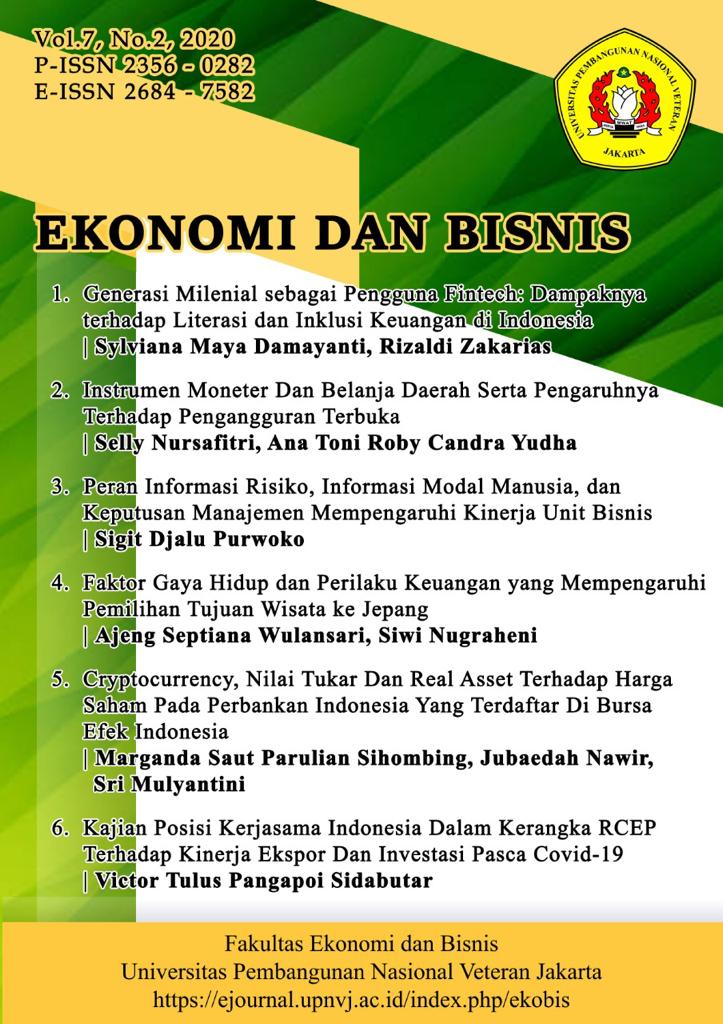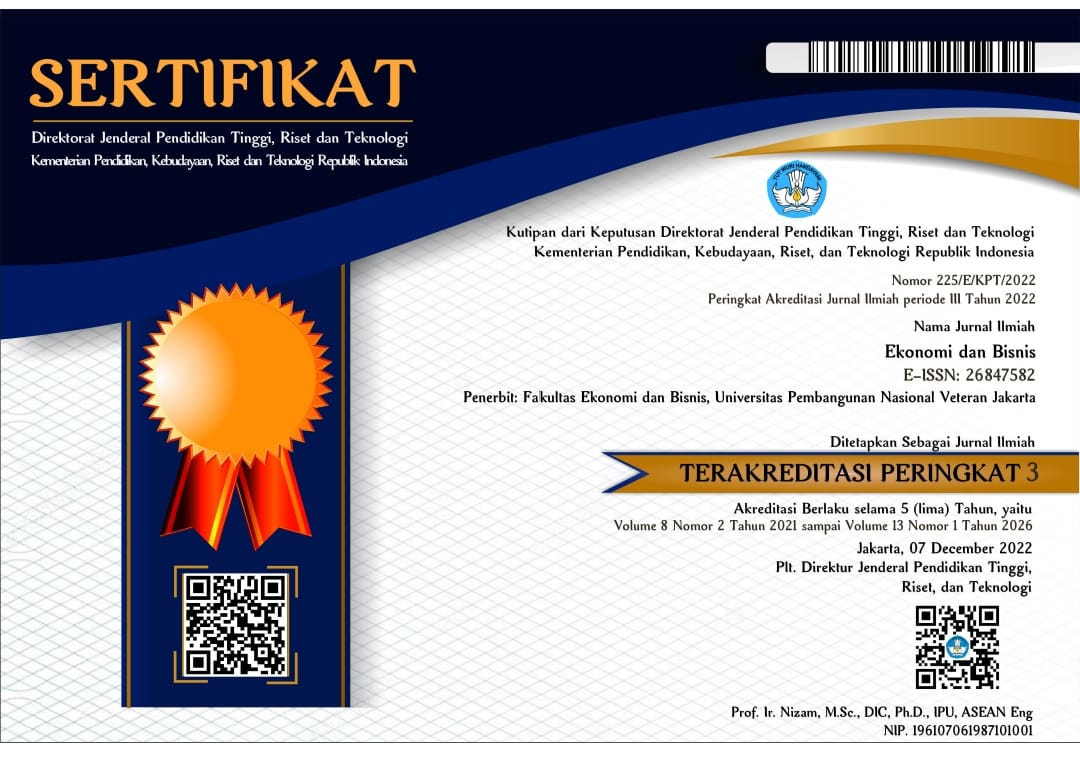Faktor Gaya Hidup dan Perilaku Keuangan yang Mempengaruhi Pemilihan Tujuan Wisata ke Jepang
DOI:
https://doi.org/10.35590/jeb.v7i2.2177Keywords:
gaya hidup, nilai tukar Yen, harga relative, keputusan berkunjung, wisatawan Indonesia.Abstract
Berdasarkan data dari Japan National Tourism Organization (JNTO), jumlah wisatawan Indonesia yang berkunjung ke Jepang sepanjang tahun 2019 sebanyak 412.800 orang wisatawan, meningkat sebanyak 4% dibandingkan dengan tahun 2018 yaitu sebanyak 396.852. Peningkatan ini bisa didasari oleh banyak hal, beberapa diantaranya adalah gaya hidup yang disokong oleh tekhnologi informasi ini juga menyebabkan batas antar negara menjadi terlihat lebih samar, sehingga hiburan yang dipilih tak hanya terbatas di dalam negeri, nilai tukar mata uang Yen dan Rupiah, serta harga relative atau jumlah pengeluaran wisatawan asing di sebuah destinasi wisata. Variabel yang diteliti dikhususkan pada faktor Gaya hidup dalam penelitian ini diidentifikasi dengan Dimensi Pengukuran Gaya Hidup AIO yaitu Activities, Interest and Opinion. Sedangkan keputusan berkunjung akan dijabarkan menjadi dua dimensi yaitu push factor dan pull factor. Penelitian ini akan diuji mnggunakan Partial Least Square (PLS).
References
SINDOnews.com. (2019). SINDOnews.com. Retrieved january 27, 2020, from https://lifestyle.sindonews.com/read/1384935/156/wisatawan-indonesia-yang-berkunjung-ke-jepang-capai-127-1552022812
Blackwell, R. D., Miniard, P. F., & Engel, J. F. (2017). Consumer Behavior. Cengage.
Chen, J. S., Huang, Y.-C., & Cheng, J.-S. (2009). Vacation Lifestyle and Travel. Journal of Travel & Tourism Marketing, 26, 494–506.
Choong, D., & Wong, Y. H. (2014). Future of Outbound Travel in Asia Pacific. Mastercard .
Choong, D., & Wong, Y. H. (2016). Mastercard Future of Outbound Travel in Asia Pacific (2016 to 2021) Report . Asia Pacific: mastercard.
Crouch, G. (1992). Effect Of Income And Price On International Tourism. Annals of Tourism Researc, 643-664.
Detik Travel. (2019). Detik Travel. Retrieved january 27, 2020, from https://travel.detik.com/travel-news/d-4823090/jelang-olimpiade-tokyo-bandara-jepang-dilengkapi-hotel-mewah
Dogru, T., Isik, C., & Turk, E. S. (2019). The balance of trade and exchange rates: Theory and contemporary. Tourism Management, 12-23.
EILAT, Y., & Liran, E. (2004). Determinants of international tourism: a three- Dimensional Panel Analysis. Routledge, 1315–1327.
Essays, UK. (2018). UKEssays. Retrieved February 2020, from https://www.ukessays.com/essays/tourism/push-and-pull-factor-in-tourism-tourism-essay.php?vref=1
Ghozali, I. (2014). Metode alternatif Dengan Partial Least Square ( PLS ). Semarang: Badan Penerbit Universitas Diponegoro.
Gil-Alana, L. A., Figueiredo, O. H., & Wanke, P. (2019). Structural breaks in Brazilian tourism revenues: Unveiling the impact of exchanges rates and sport mega events. Tourismn Management, 207211.
Google Temasek. (2017). e-Conomy SEA Spotlight. Google Temasek.
HUI, T.-K., & Yuen, C. C. (1998). An Econometric Study on Japanese Tourist arrivals in British Columbia and its Implications. The Service Industries Journal, 38-50.
Humaira, A., & Wibowo, L. A. (2016). Analisis Faktor Elektronik Word Of Mouth (EWOM) Dalam Mempengaruhi Keputusan Berkunjung Wisatawan. Tourism and Hospitality Essentials (THE) Journal, IV, 1049-1060.
Indonesia Internet Service Provider Association. (2017). Penetrasi & Perilaku Pengguna Internet Indonesia. Jakarta: APJII.
Jang, S., & Wu, C.-M. E. (2006). Seniors’ travel motivation and the influential factors: An examination. Tourism Management , 27, 306–316.
Kasali, R. (2017). Strawberry Generation. Jakarta: Mizan.
Kementrian PPN/Bappenas. (2019). Rencana Pembangunan Jangka Menengah Nasional. Jakarta: Kementrian PPN/Bappenas.
Kim, J., & Lee, K. C. (2016). Role of tourism price in attracting international tourists:The case of Japanese inbound tourism from South Korea. Journal of Destination Marketing & Management.
Koran Sindo. (2019, Maret 8). Koran Sindo. Retrieved from Koran Sindo: https://lifestyle.sindonews.com/read/1384935/156/wisatawan-indonesia-yang-berkunjung-ke-jepang-capai-127-1552022812
Muchapondwa, E., & Pimhidzai, O. (2011). Modelling International Tourism For Zimbabwe. Journal of Business And Social Science, 71-81.
Norzieiriani , A., Omar, A., & Ramayah, T. (2010). Consumer lifestyles and online shopping. Business Strategy Series, 11(4), 227-243.
Plummer, J. T. (1974). The Concept and Application of Life Style Segmentation . Journal of Marketing, 33-37.
Prayag, G. (2012). Senior Travelers’ Motivations and Future Behavioral. Journal of Travel & Tourism Marketing, 29(7), 665-681.
Prayag, G., & Ryan, C. (2011). The relationship between the ‘push’ and ‘pull’ factors of a tourist destination: the role of nationality – an analytical qualitative research approach. Current Issues in Tourism, 14(2), 121-143.
Robinson, R. N., Baum, T., Golubovskaya, M., & Solnet, D. J. (2019). Applying endosymbiosis theory: Tourism and its young workers. Annals of Tourism Research, 1-12.
Solomon, M. R. (2011). Consumer Behavior: Buying, Having, and Being. Prentice Hall.
Srihadi, T. F., Hartoyo, Sukandar, D., & Soehadi, A. W. (2016). Segmentation of the tourism market for Jakarta: Classification of foreign visitors lifestyles typologies. Tourism Management Perspective, 32-39.
Stein, J. (2013, march 20). The Me Me Me Generation. Time, pp. 1-9.
Uysal , M., & Jurowski , C. (1994). Testing the Push and Pull Factors . Annals of Tourism Research, 21(4), 844–846.
Vita, G. D., & Kyaw, K. S. (2013). Role Of The Exchange Rate In Tourism. Annals of Tourism Research,, pp. 624–627,.
Weber, K. (2001). Outdoor Adventure Tourism A Review of Research Approach. Annals of Tourism Research, 360-377.
WITT, C. A., & Witt, S. F. (1990). Appraising An Econometric Forecasting Model. Journal Of Travel Research, 30-34.
World Tourism Organization. (2019). The 21st Century Maritime Silk Road – Tourism Opportunities and Impacts. Madrid: World Tourism Organization.
Wu , J., Xu, J., & Erdogan, E. H. (2009). Investigating the Push and Pull Motivation of Visiting Domestic Destinations in China: A Means‐End Approach. Journal of China Tourism Research, 5(3), 287-315.
www.bisniswisata.co.id. (2019, April 1). Retrieved from www.bisniswisata.co.id: https://bisniswisata.co.id/2019-turis-indonesia-berwisata-ke-luar-negeri-diprediksi-107-juta/
Downloads
Published
How to Cite
Issue
Section
License
Authors who publish with this journal agree to the following terms:
Authors retain copyright and grant the journal right of first publication with the work simultaneously licensed under a Creative Commons Attribution 4.0 International License that allows others to share the work with an acknowledgment of the work's authorship and initial publication in this journal.
Authors can enter into separate, additional contractual arrangements for the non-exclusive distribution of the journal's published version of the work (e.g., post it to an institutional repository or publish it in a book), with an acknowledgment of its initial publication in this journal.
Authors are permitted and encouraged to post their work online (e.g., in institutional repositories or on their website) before and during the submission process, as it can lead to productive exchanges, as well as earlier and greater citation of published work.
This work is licensed under a Creative Commons Attribution 4.0 International License.












